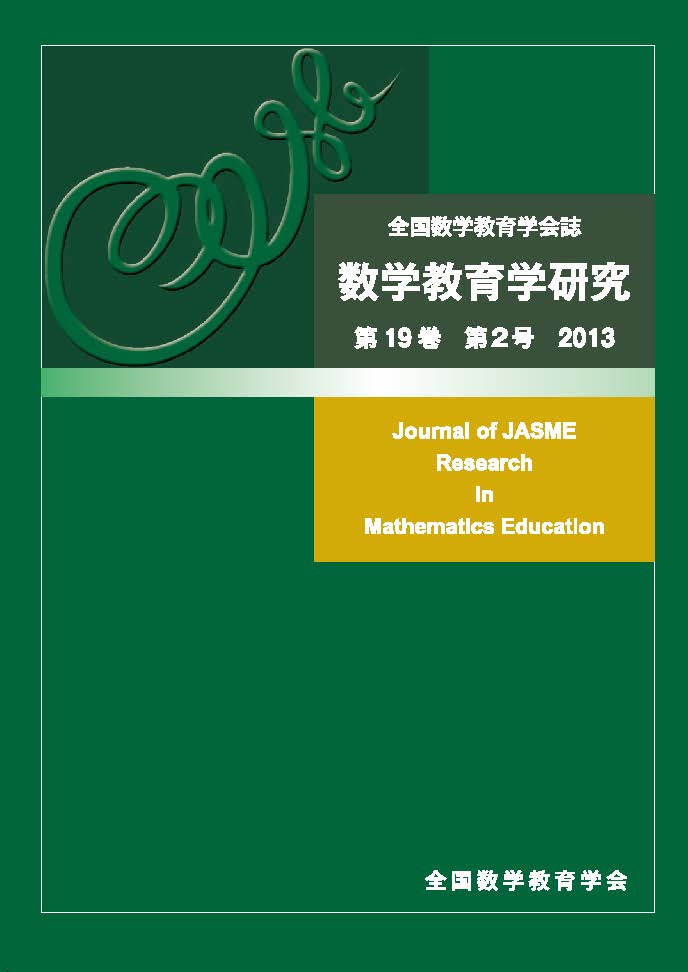19 巻, 2 号
数学教育学研究
選択された号の論文の18件中1~18を表示しています
- |<
- <
- 1
- >
- >|
-
原稿種別: 本文
2013 年 19 巻 2 号 p. 1-13
発行日: 2013/06/22
公開日: 2019/01/17
PDF形式でダウンロード (413K) -
原稿種別: 本文
2013 年 19 巻 2 号 p. 15-26
発行日: 2013/06/22
公開日: 2019/01/17
PDF形式でダウンロード (605K) -
原稿種別: 本文
2013 年 19 巻 2 号 p. 27-34
発行日: 2013/06/22
公開日: 2019/01/17
PDF形式でダウンロード (478K) -
原稿種別: 本文
2013 年 19 巻 2 号 p. 35-44
発行日: 2013/06/22
公開日: 2019/01/17
PDF形式でダウンロード (454K) -
原稿種別: 本文
2013 年 19 巻 2 号 p. 45-52
発行日: 2013/06/22
公開日: 2019/01/17
PDF形式でダウンロード (365K) -
原稿種別: 本文
2013 年 19 巻 2 号 p. 53-61
発行日: 2013/06/22
公開日: 2019/01/17
PDF形式でダウンロード (653K) -
原稿種別: 本文
2013 年 19 巻 2 号 p. 63-71
発行日: 2013/06/22
公開日: 2019/01/17
PDF形式でダウンロード (422K) -
原稿種別: 本文
2013 年 19 巻 2 号 p. 73-87
発行日: 2013/06/22
公開日: 2019/01/17
PDF形式でダウンロード (546K) -
原稿種別: 本文
2013 年 19 巻 2 号 p. 89-99
発行日: 2013/06/22
公開日: 2019/01/17
PDF形式でダウンロード (1218K) -
原稿種別: 本文
2013 年 19 巻 2 号 p. 101-108
発行日: 2013/06/22
公開日: 2019/01/17
PDF形式でダウンロード (579K) -
原稿種別: 本文
2013 年 19 巻 2 号 p. 109-115
発行日: 2013/06/22
公開日: 2019/01/17
PDF形式でダウンロード (499K) -
原稿種別: 本文
2013 年 19 巻 2 号 p. 117-126
発行日: 2013/06/22
公開日: 2019/01/17
PDF形式でダウンロード (331K) -
原稿種別: 本文
2013 年 19 巻 2 号 p. 127-140
発行日: 2013/06/22
公開日: 2019/01/17
PDF形式でダウンロード (727K) -
原稿種別: 本文
2013 年 19 巻 2 号 p. 141-150
発行日: 2013/06/22
公開日: 2019/01/17
PDF形式でダウンロード (565K) -
原稿種別: 本文
2013 年 19 巻 2 号 p. 151-159
発行日: 2013/06/22
公開日: 2019/01/17
PDF形式でダウンロード (426K) -
原稿種別: 本文
2013 年 19 巻 2 号 p. 161-174
発行日: 2013/06/22
公開日: 2019/01/17
PDF形式でダウンロード (711K) -
原稿種別: 本文
2013 年 19 巻 2 号 p. 175-183
発行日: 2013/06/22
公開日: 2019/01/17
PDF形式でダウンロード (603K) -
原稿種別: 本文
2013 年 19 巻 2 号 p. 185-201
発行日: 2013/06/22
公開日: 2019/01/17
PDF形式でダウンロード (2326K)
- |<
- <
- 1
- >
- >|
